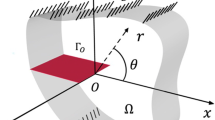Abstract
A 2-D five-noded finite element which contains a λ singularity is developed. The new element is compatible with cubic standard isoparametric elements. The main advantage of using cubic isoparametric elements over quadratic elements is to reduce the number of elements required to model a structure for results of comparable accuracy. The element is tested on two different examples. In the first example, an edge crack problem is analyzed using two different meshes. The second example is a crack perpendicular to the interface problem which is solved for two different specific composites. The results obtained using the proposed element are compared with those obtained using other existing elements in the literature. Those comparisons demonstrate the superiority of the present technique in using less number of elements and nodes to produce accurate results.
Similar content being viewed by others
References
M.L. Williams, Journal of Applied Mechanics E 19 (1952) 526–528.
T.S. Cook and F. Erdogan, International Journal of Engineering Science 10 (1972) 667–697.
R.S. Barsoum, International Journal for Numerical Methods in Engineering 10 (1976) 25–37.
J.E. Akin, International Journal for Numerical Methods in Engineering 10 (1976) 1249–1259.
D.M. Tracy and T.S. Cook, International Journal for Numerical Methods in Engineering 11 (1977) 1225–1233.
M. Stern, International Journal for Numerical Methods in Engineering 14 (1979) 409–421.
L. Ying, International Journal for Numerical Methods in Engineering 18 (1982) 959–966.
R. El Abdl, Engineering Fracture Mechanics 39 (1991) 1061–1065.
S.K. Maitti, International Journal for Numerical Methods in Engineering 33 (1992) 1955–1974.
B.K. Dutta, International Journal for Numerical Methods in Engineering 36 (1993) 2287–2303.
B.K. Dutta, Engineering Fracture Mechanics 6 (1993) 991–1003.
O.C. Zienkiewicz, The Finite Element Method in Engineering Science, McGraw-Hill, London (1971).
R.D. Cook, D. S. Malkus and M. E. Phesha, Concept and Application of Finite Element Analysis, John Wiley & Sons (1982).
P. Geyskens, W. Marien and G. De Roeck, Computer Analysis Language Modified Version, Katholieke Universiteit Leuven (1991).
D.P. Rook and D.J. Cartwright, Compendium of Stress Intensity Factors, Hmso, London (1976).
Author information
Authors and Affiliations
Rights and permissions
About this article
Cite this article
Wahab, M.A., De Roeck, G. A 2-D five-noded finite element to model power singularity. Int J Fract 74, 89–97 (1996). https://doi.org/10.1007/BF00018577
Received:
Accepted:
Published:
Issue Date:
DOI: https://doi.org/10.1007/BF00018577




